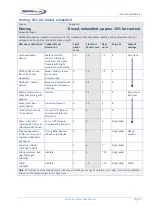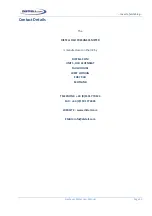
...the
art
of
distell
‐
ing...
Freshness
Meter
User
Manual
Page
51
Tilapia,
normal
handling
Species:
Tilapia
Oreochromis
lidole
Applies
to:
Normal
handling
Relationship
between
objective
sensory
scores
for
freshness,
Freshness
Meter
readings,
and
approximate
times
of
storage
in
ice
for
Tilapia.
Raw
odour
description
Cooked
flavour
description
Taste
panel
score
Freshness
Meter
score
Days
on
ice
EC
grade
State
of
spoilage
Fresh
sea
‐
weedy
odours
Watery,
metallic,
starchy.
Initially
no
sweetness
but
meaty
flavours
with
slight
sweetness
may
develop
10
13
<
2
E
Very
fresh
Shellfish
odours
and
loss
of
fresh
sea
‐
weediness
Sweet,
meaty,
creamy,
green
plant
characteristics
9
12
4
E
No
odours,
neutral
odours
Sweet
and
characteristic
flavours
but
reduced
in
intensity
8
11
8
A
Slightly
musty,
mousy,
milky
or
caprylic,
garlic,
peppery
Neutral
7
10
12
A
Decrease
in
freshness
Bread,
malt,
beer,
yeasty
odours
Insipid,
no
flavours
6
9
~
17
B
Lactic
acid,
sour
milk,
or
oily
odours
Trace
of
“off”
flavours,
some
sourness
but
no
bitterness
5
8
~
21
B
Grass,
“old
boots”,
slightly
sweet,
fruity
or
chloroform
‐
like
odours
Some
“off”
flavours,
sourness
and
bitterness
4
7
~
26
Not
graded
Stale
cabbage
water,
turnip,
sour
sink,
wet
matches,
phosphene
‐
like
odours
Strong
bitter
flavours,
rubber,
sulphide
‐
like
3
<
7
>
26
Not
graded
Nearly
spoiled
Ammonia,
strong
“byre
‐
like”
odours
2
<
7
>
26
Not
graded
Strong
ammonia,
bad
eggs
(hydrogen
sulphide)
Inedible
1
<
7
>
26
Not
graded
Putrid,
sulphides
Inedible
0
<
7
>
26
Not
graded
Putrid
Note
:
The
influence
of
seasonal
factors
on
freshness
introduces
a
range
of
variation
of
±
2
days
in
ice
in
the
estimated
values,
for
fish
stored
longer
than
2
days
in
ice.



































